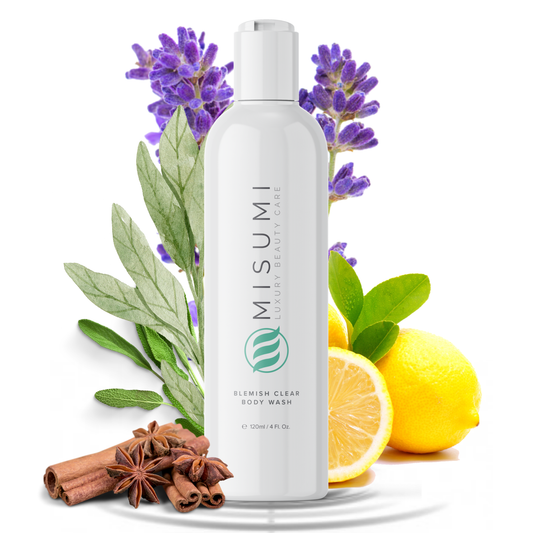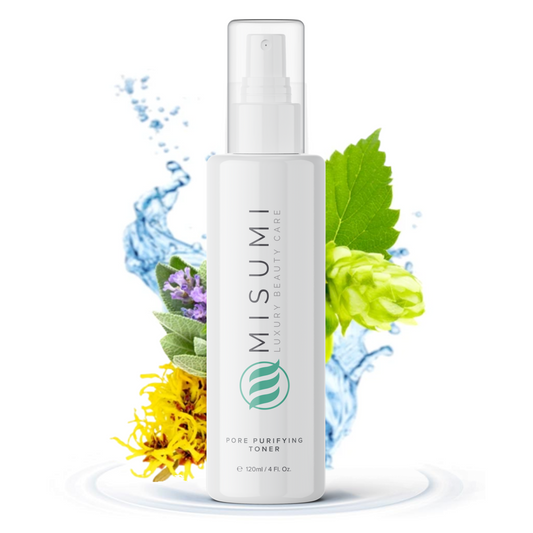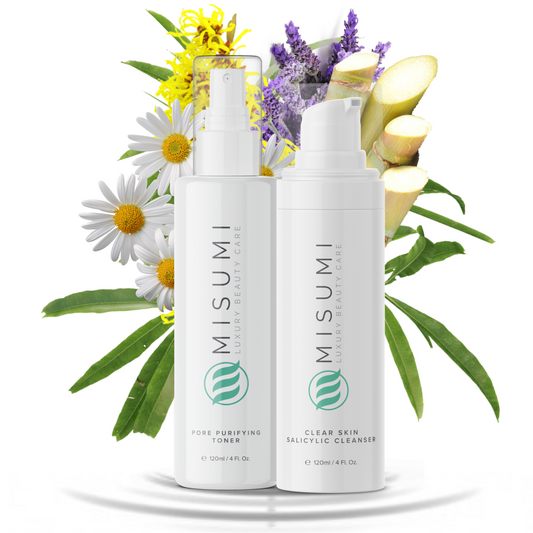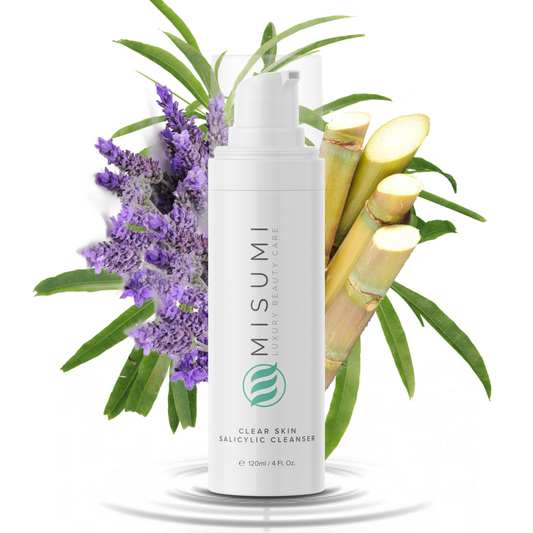Wondering how to deal with painful pimples? It may look like nothing to others, but acne is one of the most severe chronic skin conditions (besides eczema, psoriasis, and rosacea). While there’s really no fast solution for dealing with acne, most dermatologists and skin experts nowadays agree that we can get rid of acne for good.
The causes of acne are complex, and the types can vary from an innocent, small, and harmless pimple, all the way to deep, cystic acne that can leave severe acne scars.
While we’ve recommended amazing skincare products for acne (like Misumi's Complete Clear 3-Step System), and looked into all sorts of professional medications, and DIY treatments for cysts, we haven’t talked about how to deal with painful pimples - until today.

Why Do Painful Pimples Form?
We're pretty sure you’re familiar with the feeling of waking up in the morning and noticing a pimple that wasn’t there the night before. And if you’re wondering why that happened or what this sudden, surprising bout of acne is trying to tell you, you’d be right to ask yourself those questions.
But, there isn’t just one cause for acne vulgaris. Acne forms from a complex interaction of several factors. Those factors can be genetic, hormonal (hormonal acne can be caused by hormonal fluctuations), and infectious, but they can also have to do with lifestyle, harmful habits (such as smoking or vaping) or personal and poor hygiene.
One of the ways our bodies protect themselves is by ordering our skin to produce skin oil, which is also known as sebum. However, due to various genetic, lifestyle, hormonal, and sometimes even dietary factors, the production of sebum can be interfered with. When that happens, our skin starts pumping out excess oil, which can clog pores.

The Role of the Clogged Pore
Once a pore is clogged, several things can happen. It needs to be noted, however, that a clogged pore (also known as a comedo by dermatologists) is the first step toward the formation of acne (or, if you prefer, pimples).
The second step, which follows rather quickly after the first one, is that a clogged pore transforms into a whitehead (an open comedo) or a blackhead (a closed comedo) - and from there on, very quickly to acne.
This complication happens because when a pore becomes clogged, it's rarely filled up with just sebum. More often than not, microscopic dirt and dust from the environment, extra grease from foods and various skincare or other products, dead skin cells, as well as acne-causing bacteria, all wind up inside clogged pores.
As you can imagine, this combination of environmental debris and pollution, sebum, and insatiable skin bacteria isn’t up to anything good. These insatiable acne-causing bacteria are called Cutibacterium acnes (formerly known as Propionibacterium acnes). In normal conditions, they’re a fairly harmless, and constructive kind of bacteria that just minds its own business over our skin, but…

The Infection
Things begin looking worse when you realize that Cutibacterium acnes actually feed on all that goody sebum that your body has overproduced. As the acne-causing bacteria feed on the sebum, they begin multiplying too, and your body produces even more sebum. In case you haven’t realized it yet, you’ve got a bacterial infection on your hands.
However, your body doesn’t take long to figure out that it’s being attacked by an overgrowth of bacteria. So, it sends out its “marines” - the white blood cells that make up the footsoldiers of our immune system. But the existence of acne tells you that we won’t be seeing that version of a happy ending, right?
The Inflammation
See, Cutibacterium acnes has spent millennia dealing with exactly this sort of problem. As soon as it sees those white blood cells approach, Cutibacterium acnes produces a substance that tricks them into believing that our own healthy cells are actually the bacteria. The white blood cells then start attacking our cells, and congratulations - now you have inflammation, too.

Painful Pimples
To cut the story short, this acne inflammation can either become reduced or become even worse. At this point, dermatologists urge people not to squeeze their pimples, since squeezing your acne and trying to pop pimples can make the situation even worse.
While you can get rid of more superficial pimples by squeezing them, you won’t be able to get rid of larger ones. And besides, all the squeezing and pressuring of your skin causes deep damage to the surrounding tissues, making all the bacteria, pus, and the dirt go even deeper inside your skin.
That's when you end up having a large, sometimes cystic, and often a very sore spot.
You might also end up with many blind pimples. Blind pimples are where the spot forms under the skin's surface. Blind pimples can erupt under the surface, causing a visible blemish. The more you try and pop your pimples, you might just end up with recurring blind pimples.
Here's how to deal with it.
How to Deal With Painful Pimples
Let’s be clear on something - this article isn’t just merely about what you should or must do when treating sore or blind pimples. This article is also about what not to do when dealing with pimples. So with that little disclaimer out of the way, let’s look at the dos and don’ts of painful pimples treatment.

1. Do Not Squeeze or Try to Pop the Pimple
To be fair, resisting the temptation to touch our faces and popping our pimples is probably one of the most difficult things in existence. But that makes resisting temptation all the more important.
Especially when it comes to painful, deep pimples (or cystic acne), that cannot be popped when you think about it. But you can surely damage the surrounding tissue even more and turn your pimple into a bigger, worse, even more sore pimple.
Additionally, and this is perhaps even more important - you are, very likely, causing yourself some long-term, severe scars. Just don’t do it. Don’t pop and squeeze your pimples. Your future self will thank the present you one day.

2. A Warm Compress Can Soothe Painful Pimples
Warm compresses are perhaps the best invention in the entire history of humankind, and when it comes to pimples, they can help us in more ways than one.
First, a compress will divert sensations away from the pain from your pimple, enabling you to relax and take a breather. The warmth feels so much better than the sharp, and sometimes even dull but irritating, pain from the pimple.
Secondly, it will warm up your skin and the tissues surrounding the acne lesions as well. This means that your skin will become relaxed and stretched due to the heat, allowing any pus or blood to drain out and heal, making it easier to get rid of the pimples.
If you’re dealing with really persistent, sore pimples (or blind pimples), apply a warm compress to the skin surface several times a day. Boil some water in a pan and then use a clean cloth to apply it to the affected area. Alternatively, you can also buy a warm compress that can be heated up in the microwave.
Please be careful with the heat. You don’t want to burn your face; you want to heal it and get rid of the bothersome pimples. If you injure yourself, visit your doctor or dermatologist immediately.

3. Acne Stickers Can Help Sore Pimples
Acne stickers are basically little bandaids that are placed over the pimple in question. These acne stickers are supposed to protect the skin from irritation, but also kill off the bacteria infesting the acne. They also remove any pus, excess sebum, dead skin cells, random dirt, and so on. While the composition of these acne stickers can vary widely, most of them contain one or another anti-acne substance, like salicylic acid or benzoyl peroxide. (Try Misumi's Clear Skin Salicylic Cleanser.)
Not sure whether to try acne stickers? Well, there’s no harm really. They can be readily purchased over the counter at any well-stocked drug or cosmetics store. They can be used continuously until the problem goes away, but you should always read the instructions. To ensure good hygiene as well, replace any acne sticker with a new one every 24 hours.
4. Painful Pimples Hate Topical Antibiotics
As we mentioned previously, acne, and pimples, in general, can be caused by a rampant bacterial infection. And acne-causing bacteria hate antibiotics since antibiotics are specialized in kicking the butt of bacteria.
But ordinary, orally taken antibiotics can have little impact on bacteria affecting the skin, which is exactly the case with acne. Since our body is made up of millions of blood vessels, most of them microscopic. Only a very small amount of oral antibiotics - if any - can be delivered to the affected areas on the surface of the skin. This is why, when trying to get rid of sore pimples and other kinds of acne, it's best to use antibiotics that are applied topically.

As the name suggests, "topically" means that the medication is to be applied on the surface of the affected area or directly on the pimple in question. Some of the most common topical antibiotics that are used for treating acne are erythromycin and clindamycin. These usually come in a gel, or cream formulas, and they are generally applied at least twice a day. Additionally, topical antibiotics also reduce inflammation, providing an additional boon to the treatment of acne.
If you have a sensitive skin type, however, you should exercise a bit of caution since some of these topical antibiotics can dry or irritate your skin. To avoid that scenario, it's always wise to perform a patch test first.
Patch tests are easy to do, and as the name might tell you, they involve testing out a product or a substance on a small area of the skin (a “patch”). If you experience any adverse reactions, stop using the medicine, product, or ingredient in question and have a conversation with your doctor. If everything is fine, go ahead and begin the treatment.
However, topical antibiotics won’t be very effective if that’s the only thing you're using. To ensure their maximum effectiveness, it's best to combine them with other topical aids, such as high-quality cleansers that contain salicylic acid or benzoyl peroxide. Those ingredients will also help in sanitizing the area and drying out the pimple.

5. Tea Tree Oil is Helpful in Getting Rid of Pimples
In case you are out of topical antibiotics or you want to try home remedies, tea tree oil is a good natural alternative. Besides, tea tree oil is almost everywhere; you can find it at almost any well-supplied drug store or cosmetics shop.
However, not all tea tree oil formulas or products are created equal. If you intend to use this at-home treatment to combat acne, overly diluted formulas won’t help. It’s best to look for products containing at least 5% of tea tree oil or more. Generally speaking, it should be safe to use most tea tree oil products at least twice a day. But, as always, you should read the product’s label and follow the instructions that come with it - especially in severe cases.
In case you're not sure how your skin will react, perform a patch test and take it from there. Do not ingest tea tree oil.

6. Raw Honey is Good For All Types of Pimples
There are tons of over-the-counter anti-acne products that you can find in drugstores and cosmetics shops, but if you’d rather not experiment, raw honey is your go-to solution.
It’s common knowledge that honey and beeswax have medicinal properties. Honey possesses strong anti-inflammatory properties, and besides, it’s a powerful antiseptic, which means that it also keeps bacteria at bay. It's no wonder that honey was used even in Ancient Egypt, for purposes from depilation, to healing wounds and preserving materials.
But when it comes to pimples, ordinary honey found in grocery stores won’t be much help. You’ll need the rawest honey you can get, which you can apply the same as any other topical medication. Just apply raw honey over the affected area and leave it overnight.
Repeat this as many times as you want, since honey is perfectly natural and harmless. Of course, you should wash the area afterward to avoid stains or sticky incidents.
7. Try the No #1 Acne Treatment for Pimples
Misumi's Complete Clear 3-Step System is the perfect way to help tame mild acne vulgaris to severe acne (or even cystic acne). With a cleanser, toner and moisturizer included, this everyday spot treatment will remove dead skin cells, dirt, debris and inpurities. Misumi's acne fighting ingredients kills bacteria. It's great for calming breakouts and skin irritation, and reducing inflammation. Try it now!

Summing It Up
Treating deep, painful pimples is not easy. If none of the above-mentioned advice works, your best bet is to visit a dermatologist and heed their advice. Additionally, here are some basic dos and don’ts when treating pimples.
DOs
- Always wash your face well before attempting anything or applying various treatments.
- Wash your face gently with warm water. Painful pimples are… well, painful. You don’t want to irritate your skin even further and cause an even more severe type of acne.
- Use a mild cleanser that's, ideally, fragrance-free. Fragrances are achieved by additional chemicals in the product that can sometimes irritate your skin.
- While warm compresses can help, ice packs can be used to reduce swelling and sensations of pain. Need a homemade ice pack? Just wrap an ice cube or two in a clean paper towel and hold it to the skin's surface for 10 minutes.
- Apply benzoyl peroxide periodically. Benzoyl peroxide reduces the number of bacteria by inducing oxygen into the area, and besides, it cleans your skin and pores. But be careful not to apply too much since this substance can irritate your skin.
- When dealing with a closed comedone (clogged pores), or in other words, a whitehead - apply warm compresses to help the skin relax, which can make the pimple drain itself.
- Always perform a patch test before using any product, ingredient, or medication.
- Visit a doctor at any point during this treatment.

DON’Ts
- The American Academy of Dermatology suggests never trying to squeeze or pop sore pimples. Whether you have blackheads and whiteheads, or blind pimples, and deep bumps, do not! Chances are they’re sore because they go deep and have developed cysts that aren’t visible from the surface. Squeezing the surrounding tissue will cause damage to your skin and spread the infection, making the painful pimple even more uncomfortable. You don’t want that.
- Don’t apply toothpaste or other risky ingredients to the inflamed area. Toothpaste and most oils are comedogenic, which means they can clog your pores. Additionally, toothpaste contains ingredients such as alcohols, menthols, baking soda, and hydrogen peroxide that can irritate your skin condition even further.
- We don't advise trying out every homemade treatment posted online. Sure, a homemade carbon mask may have worked well for some, but all those glues and irritating ingredients can burn your skin. So, exercise caution.
That's pretty much it. We hope all of this will be helpful to you. If your pimple problem has been going on for a long time and it doesn’t go away, seek the opinion of doctors and dermatologists. Professionals are professionals for a reason. They can provide the best advice and acne treatments, and that's something you owe to yourself and your body.
References
American Academy of Dermatology - How to treat deep, painful pimples
Cutibacterium acnes (formerly Proprionibacterium acnes)
Fact Sheet: Cutibacterium acnes
This information is meant to supplement, not replace advice from your doctor or healthcare provider and is not meant to cover all possible uses, precautions, interactions or adverse effects. This information may not fit your specific health circumstances, and its goal is to offer a general view of the subject. In case you are suffering from a severe case of acne, you should consult with a dermatologist or a certified medical professional.









